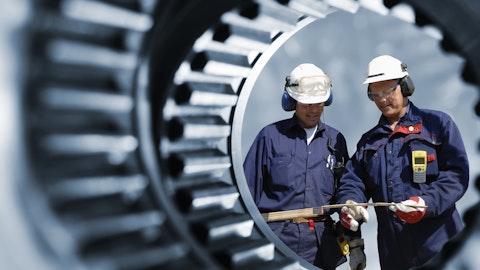Tony Guzzi: No. That’s not true. We just reallocate our resources. So we were very good at – in the fire and life safety world at large big box retail distribution centers. That slowed down on the dry goods side. That – they’re very capable people. We move that capability to other places like battery plants, like semiconductor plants through training, through very careful, do one, do it right and get it right. We have a great team there, and we build that. So yes, there’s slowdowns. I mean there are certain markets – I don’t think the New York guys are running around spiking the ball in the end zone right now. They’re working hard, and they’re doing fine. But you wouldn’t say that’s a booming market. There’s no Hudson Yards.
There’s none of that that happening right now. Maybe a little slowdown in the Northeast overall, but that’s been overcome by other parts of the country. I mean nothing is always up and to the right, as you know, Adam. I mean commercial, yes, we’re not really in the light commercial business in any significant way, even in Building Services other than some of the maintenance contracts. So yes, I mean, we have our share of challenges. But luckily, we have more good than those challenges right now. Jason, do you have anything to add?
Jason Nalbandian: I think you covered it, Tony.
Adam Thalhimer: Absolutely. All right. Thanks, guys. Appreciate the time.
Operator: And we continue with a question from Alex Dwyer from KeyBanc. Alex, you may go ahead.
Alex Dwyer: Hi, team. Congrats on a great start to the year.
Tony Guzzi: Thanks.
Alex Dwyer: So I just wanted to ask about the productivity improvements we’ve seen over the past year. Like how broad-based have these improvements been in the business? Is it concentrated in a couple of end markets or projects or geographies? I just want to get a better sense for how much more room there is to run in like implementing prefab and virtual design and then throughout the broader company.
Tony Guzzi: Now look, Alex, the reality is we’re every day trying to figure out that impact on our ongoing margins versus more favorable contract terms. I would say most of our margin enhancement is coming from execution. I mean any job we do, there’s plenty of competition. I mean there’s other people that know how to do this work. And so I never sit there and think about we have very capable competitors in every business that we have. So we’re earning margins because we’re earning them. And it’s hard to separate. I would say this in general, right? The place where you have a multiyear build, like some of these data center markets or semiconductor markets or even the manufacturing sites, where you have a multiyear build, you get better.
Your people get better, they get more productive. We think better ways to do it. And if the mix of contracts skew more for us towards fixed price versus GMP with a fee, then we do better. If we can convert more GMP to fixed price, that’s good for us and the owner because we have certainty – they have certainty of cost and somewhere 50%, 60% along the way, we also have certainty of outcome or we think we do. So it’s hard to separate some of that stuff. I will tell you this, though, right? The more work we can do in the shop versus in the field, the better we do. The more we can get in the planning earlier with our VDC, virtual design construct, and implement more of those tools, the earlier we can do that, the better off we were. And so I’ll just give you a broad number.
And we have – we were probably around 500 VDC people, mainly BIM operators in 2019, end of 2018. Today, that number is 1,500. Now you could draw a correlation between that and our margin increase. I think that’s part of it that we’re doing more. And it goes beyond prefab. A lot of times, we simplify VDC to prefab but it goes way beyond that. It goes to – we have a couple of people that are really good. You start to build things in 40 or parametric, right? And what you’re doing is you’re finding the mistakes before you go to the site. And if you can find the mistakes before you go to the site and the collisions and all the things that are going to go wrong, then you perform better, right? The most frustrating thing in the world for a foreman or a trade person or project engineer, project manager is to have installed something and then have to take it out or have someone take your work out because they didn’t get it right.
And our people don’t like rework even if we get paid for it. That’s not – you got folks are really proud of the work. Quality also goes up, right, with VDC, whether it’s field installed or whether it’s shop because, again, if you went to a construction site today, and it’s almost any site, even the smaller projects, our guys, for the most part, are looking at something on an iPad or a workstation. And they’re looking at what they’re going to build in three dimensions on that iPad. And they visually see what they’re going to build and what it should look like versus trying to read it in two dimensions just off a drawing. And our technology has seeped through the organization, and we really have taken the tools. Now we just take tools to make them better.
We don’t self-develop any of these tools because there’s good tools out there. But we’ve really taken leadership of that. And we have a dedicated group that does that now in our construction segment to work together on electrical, mechanical. It’s not that different. The mechanical is probably a little more complex and advanced than the electrical folks on this because think about there’s flows happening or systems or the electrical is it’s more rigidity, conduit and runs, right? But both are doing more of it. And with electrical guys think about when they do VDCs, how do I take something I’m going to do 100 times and take that work out of the field so there’s less connections, and the connection is easier. That’s broadly speaking how they think about it.
And then we’re doing more skids and assemblies in both mechanical and electrical. And again, that makes it more rigorous. It makes it more stable when it gets to the field and be able to be built. So I’d say is it half of why we’re doing better productivity, sure. And then some of it is just working better because we’ve done these jobs multiple times. And look, EMCOR is a wonderful peer learning environment. So that’s the construction side. When you get to the smaller project, mechanical service side, it’s a little different. There, when you’re doing a project a lot of times, productivity is almost secondary to making sure you don’t disrupt the owner. And then it becomes a logistical game because you’re usually operating in a build site, right?
So they got to keep working. And so our guys have to really understand that, get the logistics right, get that in and get the building up right. So when you’re doing a retrofit product, especially a midsized to medium-sized and smaller one, there you’re thinking about how do I make my customer more productive when I do it. And then how do I make sure that I’ve covered all my contingencies when I have to do these very complex logistical jobs in a build site. So that’s a long-winded answer to what you were searching for, but…
Jason Nalbandian: I think the only thing I would add, you asked specifically about investments in certain markets or different sectors. And I think, right, none of these investments are targeted at a single market sector, right? The same prefabrication facility that can do a high-tech manufacturer – support a high-tech manufacturing project can support a health care project or any other sector that we’re working in. And the same thing with VDC or BIM, right? It’s not targeted at any subset of our work other than more so to our construction side than our service side.
Tony Guzzi: Maybe, Jason, talk a little bit about how CapEx moved here and how do we build or build infrastructure…
Jason Nalbandian: In the quarter, relatively comparable year-over-year. But I think if you go to a full year of 2023, that’s when you’d really see it compared to the full year of 2022. I think our CapEx was up roughly 60%, and that really was a lot of these investments that Tony has been talking about. And we’ll continue to invest in prefab facilities. We’ll continue to invest in BIM. We’ll expand the facilities that we have where we need more capacity. And we’ll find ways to add facilities in other markets where we currently don’t have the same capacity we do elsewhere.
Tony Guzzi: But all our investments, someone asked the question earlier about are these top-down or are they bottom up? They’re bottom up, but there’s a receptive knowledgeable here [ph] at the top to ascertain where the best way to invest and also to provide resources when needed to help them invest. We haven’t turned down a significant capital investment here in five years. I only say five years, I don’t remember before that, because our folks bring these forward, they tend to be very well thought. And they’re taken – and as a contractor, just so we understand that too, our folks are looking for less than four-year cash payback when they make that infrastructure investment because we do think like contractors, right?
We’re looking at the current market and say, this is good for today, it’ll be good for the future, but let’s make sure we can earn today. And the other thing is we – 95% I always qualify things, probably it’s 100%, but 95% of our prefabrication for us in our jobs. We don’t prefabricate for the market.




